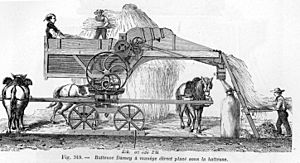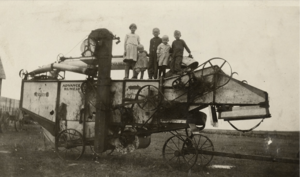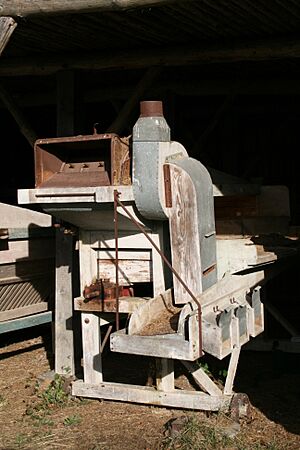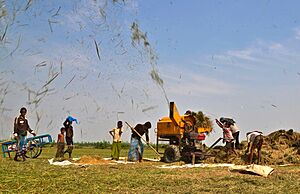Threshing machine facts for kids
A threshing machine or thresher is a special piece of farm equipment. It helps farmers separate grain seeds from the plant stalks and husks. Imagine beating the plant to make the seeds fall out – that's what it does!
Before these machines existed, people had to do this work by hand using tools called flails. This was very hard and took a lot of time. In the 1700s, about a quarter of all farm work was just threshing by hand!
The first threshing machine was invented around 1786 by a Scottish engineer named Andrew Meikle. This invention was a big step in making farming easier and more modern. During the 1800s, threshers and other machines like reapers (which cut crops) became common. They made growing grain much less difficult for farmers.
Today, many farmers use a machine called a combine harvester (or just "combine"). This machine does everything: it cuts the crop, threshes it, and cleans the grain all at once! However, simpler threshing machines are still important in places where farmers don't have a lot of money or on small farms. For example, some Amish communities still use horse-drawn machines and old-style threshers.
Contents
How Threshing Machines Changed Farming
When threshing machines first became popular, they changed farm work a lot. They made it much faster to get grain ready. This meant farmers didn't need as many workers.
In the UK, these changes led to some problems for farm workers. In 1830, many workers were struggling because of low wages and fewer jobs. The new threshing machines meant even less work for them. This caused some people to protest and even break threshing machines. These protests were called the Swing Riots.
The Evolution of Threshing Machines
Early threshing machines were often powered by horses. Sometimes, they were even built inside special buildings called gin gangs, connected to a barn. These first machines were quite small, about the size of a tall piano.
Later, machines became much bigger and were powered by steam engines. These engines were often portable or on wheels, like a small train engine. In 1834, John Avery and Hiram Abial Pitts made big improvements to threshing machines. Their machines could automatically separate the grain from the husks, which saved farmers even more time and effort.
An Australian inventor named John Ridley also developed a threshing machine in Australia in 1843.
In 1881, a book called the Household Cyclopedia talked about how amazing Meikle's machine was. It said that the machine not only separated the grain but also cleaned it. It even said that the machine could get more grain from the crop than old methods. This saved a lot of money and effort for farmers.
The book also mentioned that using horses to power the machines was expensive. It suggested that on larger farms, it would be better to use wind or water power if possible. If coal was cheap, steam power could also be used.
Steam-powered threshing machines often used long belts connected to a traction engine (a type of steam tractor). Often, a special contractor would own both the engine and the thresher. They would travel from farm to farm to help with the harvest. Steam power was used for threshing until after World War II.
Modern Threshing Technology
Combines in Europe and the Americas
Today's combines work using the same basic ideas as the first threshing machines. But they also cut the crop at the same time. The name "combine" comes from the fact that it combines two jobs into one machine. Most modern combines have their own powerful diesel engines and can drive themselves.
Here's how a modern combine threshes grain:
- The machine has a spinning cylinder with sharp bars. As the plant material is fed in, the cylinder spins very fast (about 500 times a minute!).
- The bars beat the plants against a curved screen called a concave. This beating makes the grain fall through holes in the concave.
- The straw and husks are then moved to the back of the machine by "walkers." Any leftover grain falls out here.
- A fan blows air to remove dust and light bits of plant material.
- The grain then goes through sieves (screens) that shake. The top sieve removes bigger pieces, and the bottom one separates clean grain from pieces that weren't fully threshed.
- Any grain that wasn't fully threshed goes back to the cylinder to be processed again.
Older threshing machines sometimes had a "bagger" that filled bags with grain. A worker would sew the bags shut. Modern combines have a large grain tank that holds the grain until it can be unloaded into a truck or wagon.
Combines usually chop up the straw and spread it back onto the field. This helps return nutrients to the soil. Farmers can also turn off the chopping if they want to collect the straw for other uses, like making hay bales.
Farmers need to adjust combines carefully for different crops. Things like the speed of the cylinder and the size of the sieves must be set just right.
Threshing in Asia
In Asia, especially for rice (a very important crop), different types of petrol or diesel-powered threshing machines were developed in the early 1900s.
Even with combines, a smaller, wheeled thresher called a "harvester" is still used in some places. These compact machines are great for small fields on mountainsides where a large combine can't go. Farmers in these areas often use these smaller harvesters with a modern compact binder (a machine that cuts and ties crops into bundles).
Preserving History
Many old threshing machines have been saved and restored. You can often see them working at special events like live steam festivals and traction engine rallies. These events show how these amazing machines helped change farming forever!
See also
- Living van
- Swing riots
- Threshing
- Rice huller
- Threshers, pedal powered
- Russell & Company (Steam Tractor)





